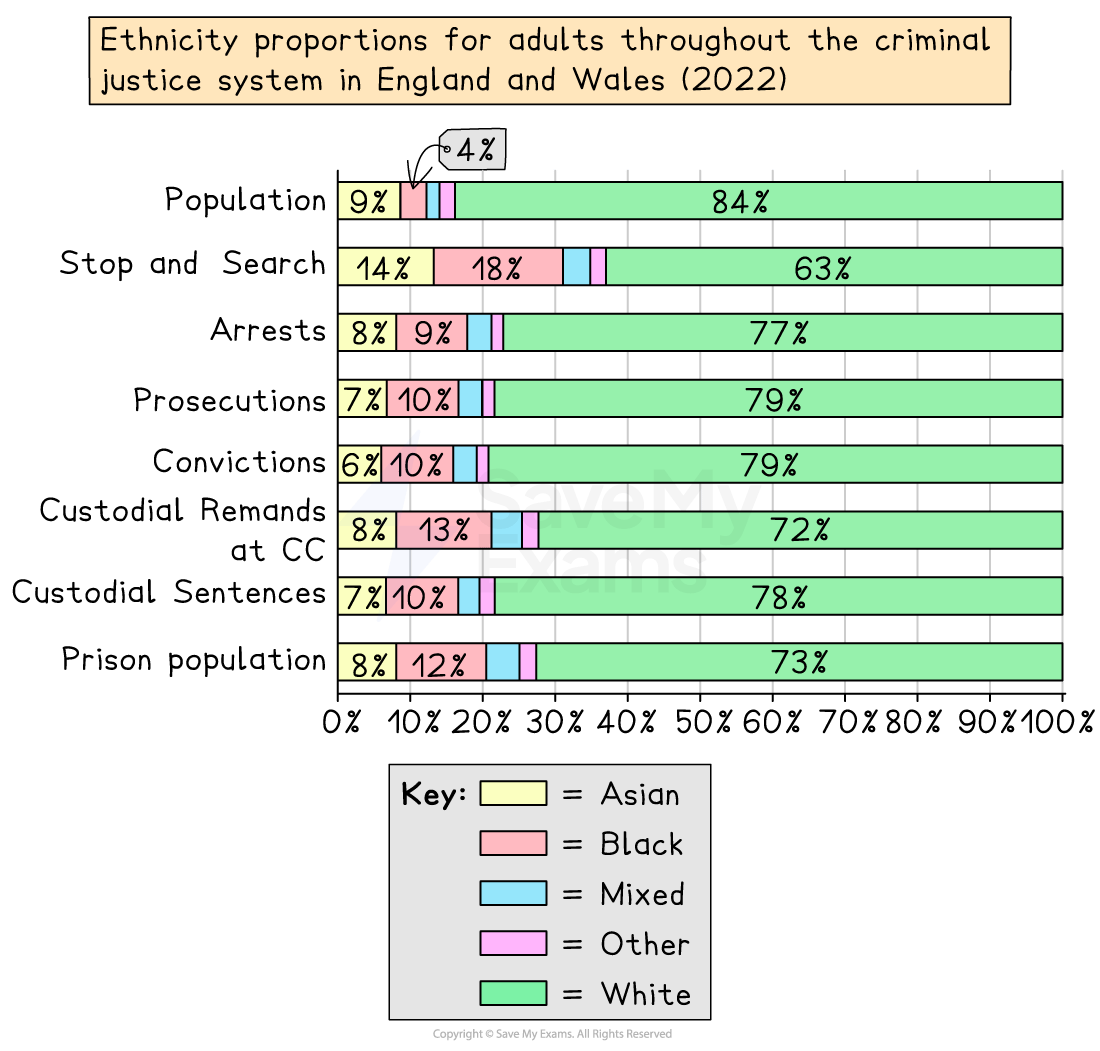The Relationship Between Ethnicity & Crime (WJEC Eduqas GCSE Sociology): Revision Note
Exam code: C200
Official statistics on ethnicity & crime
According to the Ministry of Justice (2024):
some ethnic groups are over-represented in the prison population relative to their share of the UK population
black prisoners serve a greater proportion of their sentences (68%) than white (59%) or Asian (58%) prisoners
According to the Home Office (2024):
in the year ending March 2023, there were 24.5 stop and searches per 1000 black people and 5.9 per 1000 white people
This suggests possible racial profiling and over-policing of ethnic minorities.

Victims of crime
Data from the CSEW (2014/2015) shows that the risk of being a victim of personal crime varies according to ethnicity
4% of white adults were victims of a personal crime once or more in the previous 12 months, compared to around 11% of adults of mixed heritage
The CSEW also shows variations in the proportion of people from different ethnic groups who see the CJS as fair
A higher proportion of adults that are Asian or Asian British are confident the CJS is fair compared to white adults
Explanations for the link between ethnicity & crime
There are several ways sociologists have explained the relationship between ethnicity and involvement in crime
Poverty and deprivation
Some ethnic minorities are more likely to live in poverty or face unemployment, which increases the strain to achieve material success legally (Merton’s strain theory)
Working-class subcultures may emerge as a response to blocked opportunities
Crime may be seen as a rational response to economic marginalisation
Institutional racism and bias in the CJS
Ethnic minorities, particularly black people, are more likely to be stopped, searched, arrested and imprisoned than white people
The Macpherson Report (1999) — published after the Stephen Lawrence murder inquiry (see below) — concluded that the Metropolitan Police were institutionally racist
It showed that racial prejudice was built into police practices and culture, not just individual attitudes
Institutional racism can lead to over-policing of black communities and under-protection when they are victims
The Stephen Lawrence case
Stephen Lawrence, a Black A-level student, was murdered by a group of white men in London
Police failed to investigate properly, ignoring witnesses and evidence due to racist assumptions
After years of campaigning by his family, the Macpherson Inquiry (1999) exposed institutional racism within the police
The case led to major reforms in police recruitment, diversity training, and race relations law
The myth of black criminality
Gilroy (1982) argued that the idea of higher black criminality is a myth created by racist media and policing
He saw black crime as a form of political resistance against discrimination, inequality and colonial oppression
Scapegoats and moral panics
Stuart Hall (1979) studied how media coverage of “muggings” in the 1970s created a moral panic
The media exaggerated the threat of black youth crime, using it to divert attention from economic problems such as unemployment and strikes
The state and media scapegoated black youth, reinforcing racist stereotypes and justifying tougher policing
Modern parallels can be drawn with Islamophobia and the portrayal of Muslim communities after terrorist incidents
Policing styles and reform efforts
Police forces have been criticised for disproportionately targeting ethnic minorities through stop-and-search practices
Efforts to reform policing include:
recruiting more ethnic minority officers
improving training on cultural awareness
However, ethnic minorities still make up only 12% of London’s police, compared with 40% of the city’s population
Evaluation of the relationship between ethnicity & crime
Strengths
Poverty and deprivation are recognised as key social causes of crime among some ethnic groups, showing that inequality is an important factor
Modern theories now consider how class, ethnicity and gender interact to shape people’s experiences of crime and justice
Research has led to positive reforms, such as increasing police diversity, accountability and anti-racism training
Criticisms
Critics argue that Gilroy romanticised black crime and ignored the fact that most victims of black offenders are also black
Hall’s ideas may be outdated, as his 1970s “moral panic” theory doesn’t fully explain modern crime patterns
Some theories overgeneralise ethnic groups, overlooking important cultural and social differences within minority communities
Examiner Tips and Tricks
Higher-level extended writing answers tend to discuss how a combination of factors, such as social class, gender and age, can explain criminal and deviant behaviour.
Merton and Cohen's work (on social class) is especially relevant here because some ethnic minorities may commit crimes as they are more likely to be concentrated in the lower social classes.
Alternatively, Becker's work can be used to explain the link between ethnicity and crime, as the labelling of black people can explain why they are over-represented in the CJS.

Unlock more, it's free!
Did this page help you?